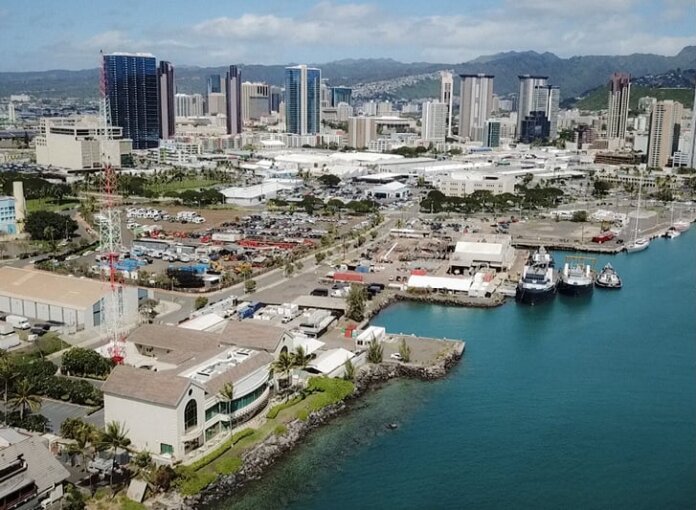By: Puanani Fernandez-Akamine
In 2012, the State of Hawaiʻi transferred approximately 30 acres of land in urban Honolulu to the Office of Hawaiian Affairs (OHA). The land, valued at $200 million, was offered to OHA in lieu of more than 30 years of unpaid pro-rata share of income and proceeds from the Public Land Trust (PLT) owed to Native Hawaiians.
The 30 acres are comprised of 10 separate parcels of land located on a peninsula in the heart of Honolulu known as “Kakaʻako Makai,” adjacent to Kewalo Basin. After receiving the land in settlement of PLT obligations, OHA reached out to Native Hawaiians across the pae ʻāina via a series of “visioning” meetings to discuss ideas for development of the land.

OHA’s vision has always been to utilize these lands in a way that balances commerce and culture; to ensure that the land will be developed in such a way that it not only generates revenue for the betterment of Native Hawaiians, but that it also creates a Hawaiian “sense of place.”
These lands were once part of a large complex of fishponds, reefs and extremely productive fishing grounds. Traditionally, the larger area now known as Kakaʻako went by other names – Kukuluāeʻo in the east, Kaʻākaukukui in the west, and the inland area was known as Kewalo.
The work that began more than a decade ago included renaming the area, and in recent months that effort was renewed. In collaboration with renowned Kumu Cy Bridges, a new name for the area has been proposed: Hakuone.
“Naming is an important cultural practice,” notes OHA CEO Dr. Sylvia Hussey. “Whether naming a child, a place or a home, naming is done with great thought and intention. A name can foreshadow the realization of greatness. It was important for OHA to give this land a name with great thought and intention – rather than retain the name that the state gave to the parcels when they settled their Public Land Trust obligation.”
Hakuone means “a small land division cultivated for a chief” – in this context it metaphorically represents OHA on behalf of the lāhui, according to Bridges. In addition to the literal meaning of the name, there are layers of kaona (hidden meaning) as well.
“The word ‘haku’ means ‘to compose, create, put in order, arrange, braid,’ such as a haku lei,” explained Bridges. “Haku mele means to compose a song or chant. So it is hoped that we will accomplish our goals by weaving together all of the important elements necessary to fashion a beautiful, haku lei that will be held firmly together as it should in that process.
“‘Haku’ also means ‘lord, master, owner.’ [So] we’re trying to cultivate the property to preserve and share the best of who we are and bring recognition and pride to Hawaiʻi and to our kūpuna, the source of who we are as a Native people. And we will always need Ka Haku, The Lord, and His guidance and inspiration in all that we do. The recognition and acknowledgment of deity was intricately woven into the fabric of our culture and is who we are as Kānaka Maoli,” said Bridges.
The word “one” means sand, but poetically it refers to land – such as in the phrase “kuʻu one hānau” (my birth land). “It’s also tied to the word “hoʻōne” which is the pumice stone used by the ancients to polish their artwork,” added Bridges. “So poetically it refers to smoothing out situations within communities and families.”
Hussey compares the layers of kaona in the name Hakuone to OHA’s vision for the land. “There are so many layers of thought in the name Hakuone – and I see that OHA’s vision has many layers too – it is our role to haku these many elements together to better the conditions of Native Hawaiians .”
OHA’s leadership wants to see Hakuone reborn and its abundance restored; a revitalized wahi pana that we can enjoy together, one characterized by aloha and an authentic Hawaiian aesthetic.
“I believe that when all is said and done, our people and visitors will not be the only ones returning and enjoying the uniqueness of Hakuone,” said Bridges. “Our kūpuna will return and their presence will add a whole dimension that will be felt and understood by Native Hawaiians and those special few who are Hawaiian at heart.”
“It is my dream that Hakuone will serve as an economic engine for our Hawaiian people for generations to come,” added OHA Board Chair Carmen “Hulu” Lindsey.
Original post can be found at: https://kawaiola.news/oha/introducing-hakuone-ohas-landholding-at-kakaʻako-makai-reimagined/
